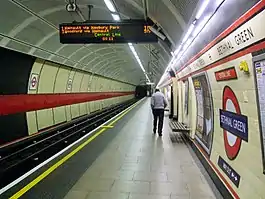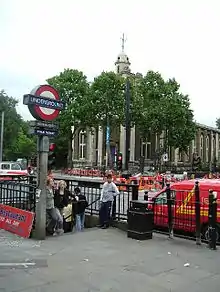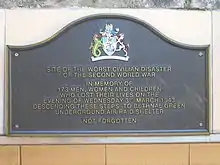Bethnal Green tube station
Bethnal Green is a London Underground station in Bethnal Green, London, served by the Central line. It lies between Liverpool Street and Mile End stations, is in Travelcard Zone 2, and is open 24 hours on a Friday and Saturday as part of the Night Tube service. The station was opened as part of the long planned Central line eastern extension on 4 December 1946, having previously been used as an air-raid shelter. On 3 March 1943, 173 people, including 62 children, were killed in a crush while attempting to enter the shelter, in what is believed to be the largest loss of civilian life in the UK during the Second World War.
| Bethnal Green | |
|---|---|
 Eastbound platform | |
 Bethnal Green Location of Bethnal Green in Greater London | |
| Location | Bethnal Green |
| Local authority | London Borough of Tower Hamlets |
| Managed by | London Underground |
| Owner | Transport for London |
| Number of platforms | 2 |
| Fare zone | 2 |
| London Underground annual entry and exit | |
| 2015 | |
| 2016 | |
| 2017 | |
| 2018 | |
| 2019 | |
| Railway companies | |
| Original company | London Passenger Transport Board |
| Key dates | |
| 4 December 1946 | Station opened |
| Other information | |
| External links | |
| WGS84 | 51°31′38″N 0°03′20″W |
The station is an example of the style adopted by London Transport for new tube stations under the New Works Programme of 1935–1940. Extensive use is made of pale yellow tiling, originally manufactured by Poole Pottery. This has been replicated during the 2007 modernisation although several panels of original tiling were retained on the platforms. The finishes include relief tiles, showing symbols of London and the area served by the London Passenger Transport Board, designed by Harold Stabler. The station entrances, all in the form of subway access staircases to the subterranean ticket hall, all show the design influences of Charles Holden, the consulting architect for London Transport at this time.
History
Development
The 1935–40 London Passenger Transport Board (LPTB) New Works Programme included a new deep level station in Bethnal Green as part of the Central line extension from Liverpool Street to Ongar and Woodford over the London & North Eastern Railway suburban branch to Epping and Ongar in Essex, as well as a new underground line between Leytonstone and Newbury Park mostly under the Eastern Avenue to serve the new suburbs under-development in the north Ilford and the Hainault Loop.[4]
Wartime disaster
Construction of the Central line's eastern extension was started in the 1930s, and the tunnels were largely complete at the outbreak of the Second World War although rails were not laid. The facilities at Bethnal Green were requisitioned in 1940 at the onset of the first Blitz and administration was assigned to the local authority, the Metropolitan Borough of Bethnal Green, under the supervision of the "Regional Commissioners", the generic name for London civil defence. Heavy air raids began in October and thousands of people took shelter there, often remaining overnight. However, usage of the shelter dwindled in 1941 as the air forces of Germany and Italy were redirected away from the United Kingdom and against the Soviet Union. A relative lull occurred although the number of shelterers rose again when retaliatory bombing in response to Royal Air Force raids was expected.
This was the case on 3 March 1943, after British media reported a heavy RAF raid on Berlin on the night of 1 March. The air-raid Civil Defence siren sounded at 8:17 pm, triggering a heavy but orderly flow of people down the blacked-out staircase from the street. A middle-aged woman and a child fell over, three steps up from the base and others fell around her, tangled in an immovable mass which grew, as they struggled, to nearly 300 people. Some got free but 173, most of them women and children, were crushed and asphyxiated. Some 60 others were taken to hospital. News of the disaster was withheld for 36 hours and reporting of what had happened was censored, giving rise to allegations of a cover-up, although it was in line with existing wartime reporting restrictions. Among the reports which never ran was one filed by Eric Linden of the Daily Mail, who witnessed the disaster. Information which was provided was very sparse.[5][6] Fuller details were eventually released on 20 January 1945, the cause having been "kept a secret for 22 months because the government felt the information might have resulted in the Germans' continuing air raids with the intention of causing similar panics".[7] When Prime Minister Winston Churchill saw the report on 6 April saying that the cause was public panic during an air raid, he determined that it should be suppressed until the end of hostilities as it would be an "invitation to repeat" to the enemy and also as it contradicted earlier official comments that there was no panic; although Herbert Morrison disagreed, and Clement Attlee (MP for the nearby Limehouse constituency) wanted to deny rumours swirling about that the panic was due to "Jews and/or Fascists".[8]
The results of the official investigation were not released until 1946.[9][10] At the end of the war, the Minister of Home Security, Herbert Morrison, quoted from a secret report to the effect that there had been a panic, caused by the discharge of anti-aircraft rockets, fired from nearby Victoria Park. During the war other authorities had disagreed: the Shoreditch Coroner, Mr W. R. H. Heddy,[11] said that there was "nothing to suggest any stampede or panic or anything of the kind"; Mr Justice Singleton, summarising his decision in Baker v Bethnal Green Corporation, an action for damages by a bereaved widow, said "there was nothing in the way of rushing or surging" on the staircase;[12] while the Master of the Rolls, Lord Greene, reviewing the lower court's judgment, said "it was perfectly well known .. that there had been no panic".[13] Lord Greene also rebuked the Ministry for requiring the hearing to be held in secret.
The Baker lawsuit was followed by other claims, resulting in a total payout of nearly £60,000, the last of which was made in the early 1950s. The secret official report, by a Metropolitan magistrate, Laurence Rivers Dunne, acknowledged that Bethnal Green Council had warned London Civil Defence, in 1941, that the staircase needed a crush barrier to slow down the crowds, but was told that would be a waste of money.[14]

The crush at Bethnal Green is thought to have been the largest single loss of civilian life in the UK in the Second World War and the largest loss of life in a single incident on the London Underground network. The largest number killed by a single wartime bomb was 107 at Wilkinson's Lemonade Factory in North Shields (1941),[15] though there were many more British civilians killed in single bombing raids.[16]
Contemporary
On 5 July 2007, a westbound Central line train struck a roll of fire-resistant material which was lying on the track between Mile End and Bethnal Green stations. The first three bogies of the train were derailed and the driver applied the emergency brake, stopping the train after 148 m. There were no serious injuries caused by the derailment, but 20 passengers received medical treatment. All 520 passengers were evacuated from the train along the tunnel to Mile End station. The derailment also caused some damage to the first two carriages of the train, to the track and to one signal. The immediate cause of the incident was a roll of fire-resistant blanket, approximately 1.8 m long, lying across one rail. The blanket had been stored in a passage the previous night and weighted down, but the wind from passing trains had caused it to unfurl and fall onto the line. There were four causal factors and four contributory factors related to the incident. The underlying cause was the lack of a comprehensive risk analysis being performed to support the use of fire-resistant blankets.[17]
Frank Wang had sold coffee to commuters from his van at the northern exit of the station the nearby site of a disused public toilet behind his stall was being converted into a beach bar called Chiringuito, leading to the coffee vendor’s electricity supply from the station being cut off as a result early in 2018.[18] Tower Hamlets Mayor John Biggs, one of Frank’s long-standing customers came out in support along with the local community, the Chinese community and commuters who protested.[19]
Commemoration of wartime disaster


Memorials
A plaque commemorating the 1943 disaster was erected on the station's south-eastern staircase, on which the deaths occurred, for the fiftieth anniversary in 1993. It bears the coat of arms of the London Borough of Tower Hamlets, and records the event as the "worst civilian disaster of the Second World War".[20]
The "Stairway to Heaven Memorial Trust" was established in 2007 to create a more prominent public memorial to those who died in the disaster. The memorial was designed by local architects Harry Patticas and Jens Borstlemann of Arboreal Architecture.[21][22] It was sited in a corner of Bethnal Green Garden, immediately outside the tube station, and was unveiled on 16 December 2017, more than 74 years after the event. It takes the form of an open inverted stairway of 18 steps made of teak overhanging a concrete plinth, and is a full-sized replica of the stairway where the disaster occurred. The names of the dead are carved on the exterior and the top covering has 173 small holes allowing light through representing the dead.[23][24][25]
Other commemorations
Although the deaths were not due to enemy action, 164 of the dead are recorded by name by the Commonwealth War Graves Commission among civilian war dead in the Metropolitan Borough of Bethnal Green,[26] plus seven in the Metropolitan Borough of Stepney.[27] All are recorded as died or injured "in Tube Shelter accident".[28]
In 1975, the ITV network broadcast a dramatised television film about the disaster, It's A Lovely Day Tomorrow, directed and produced by John Goldschmidt, and with a script by Bernard Kops, who as a 16-year-old had witnessed the event.[29] The film was short-listed for an International Emmy in the Fictional Entertainment category, but lost to The Naked Civil Servant.[30]
As part of "TUBE" Art Installation in November 2013, sound artist Kim Zip[31] created an installation[32] commemorating the Bethnal Green Tube Disaster. The work was backed by the Whitechapel Gallery and promoted as part of the organisation's "First Thursdays" initiative for popular art.[33] "TUBE" exhibited over a period of four weeks in the belfry of Sir John Soane's St John on Bethnal Green Church.[34] St John's overlooks the site of the tragedy and was commandeered as a temporary mortuary on the night of 3 March 1943.
On 1 April 2016, Dr Joan Martin, who was on duty as a junior casualty officer at the nearby Queen Elizabeth Hospital for Children and led the medical team dealing with the dead and wounded from the incident, told BBC Radio 4's Eddie Mair about her personal experiences on the evening of the disaster, and its long-term effects on her life.[35]
Services and connections
Central line trains operate from the station.
The typical off-peak service in trains per hour (tph) as of 2018 is:
24tph westbound which consist of:
- 9tph to Ealing Broadway
- 9tph to West Ruislip
- 3tph to Northolt
- 3tph to White City
24tph eastbound which consist of:
- 6tph to Hainault via Newbury Park
- 3tph to Newbury Park
- 3tph to Woodford via Hainault
- 9tph to Epping
- 3tph to Loughton
London Bus routes 8, 106, 254, 309, 388, D3, D6 and night routes N8 and N253 serve the station on Bethnal Green Road, Roman Road and Cambridge Heath Road.
Future development
The Central line runs directly below Shoreditch High Street railway station on the London Overground East London line and an interchange has been desired locally in neighbouring Shoreditch since it opened in 2010. The station would lie between Bethnal Green and Liverpool Street on one of the longest gaps between tube stations in inner London. Although there would be benefits to this interchange, it was cancelled due to costs, it would cause disruption to the Central line while under construction, and because the platforms would be too close to sidings at Liverpool Street and will not be considered until after Crossrail is fully operational in 2021.[36]
Gallery
| Wikimedia Commons has media related to Bethnal Green tube station. |
 Westbound platform looking east
Westbound platform looking east Eastbound platform looking east
Eastbound platform looking east Roundel on Westbound platform
Roundel on Westbound platform Southwest entrance
Southwest entrance
References
- "Multi-year station entry-and-exit figures (2007–2017)" (XLSX). London Underground station passenger usage data. Transport for London. January 2018. Retrieved 22 July 2018.
- "Station Usage Data" (CSV). Usage Statistics for London Stations, 2018. Transport for London. 21 August 2019. Retrieved 27 April 2020.
- "Station Usage Data" (XLSX). Usage Statistics for London Stations, 2019. Transport for London. 23 September 2020. Retrieved 9 November 2020.
- Day & Reed 2010, p. 116.
- Skibbereen Eagle. "Bethnal Green tube disaster". Southern Star. Skibbereen, Co. Cork. Retrieved 22 June 2019.
- A London Inheritance (6 May 2018). "Bethnal Green's Ordeal". Retrieved 22 June 2019.
- "Disaster Said Caused By Panic in Shelter". San Bernardino Daily Sun. 51. San Bernardino, California. Associated Press. 21 January 1945. p. 4..
- Roberts, Andrew (2009) [2008]. Masters and Commanders: The Military Geniuses who Led the West to Victory in World War II. Penguin. pp. 353, 354. ISBN 978-0-141-02926-9.
- Bethnal Green – disaster at the tube, Wednesday 24 September 2003, 19.30 BBC Two Archived 13 December 2007 at the Wayback Machine
- Dettman 2010.
- Nat. Archives MEPO 2/1942
- The Times, 19 July 1944.
- The Times, 9 December 1944.
- Nat.Archives PREM 4/40/15.
- "Wilkinson's air raid shelter disaster explored". northshields173.org. Retrieved 23 August 2018.
- "Bethnal Green Tube disaster marked 70 years on". BBC News. 3 March 2013. Archived from the original on 6 March 2013.
- "Derailment near Mile End station". Rail Accident Investigation Branch. 10 December 2014.
- Cook, Victoria (10 December 2018). "'Keep Frank's Bethnal Green coffee stand open'". BBC. Retrieved 22 June 2019.
- Brooke, Mike (8 August 2018). "Protest frothing up to save Frank Wang's coffee stall outside Bethnal Green tube station". Docklands and East London Advertiser. Barking, Essex.
- "Plaque: Bethnal Green WW2 disaster – plaque". London Remembers. Retrieved 3 March 2018.
- "The Appeal". Stairway to Heaven Memorial Trust. Archived from the original on 7 March 2008. Retrieved 18 February 2009.
- Dettman 2010, pp. vii–viii.
- "Bethnal Green WW2 Tube disaster memorial unveiled". BBC News. BBC. 20 December 2017. Retrieved 20 December 2017.
- Ali, Rushanara (16 December 2017). "74 years since the Bethnal Green tube disaster, lessons still need to be learned". The Guardian. Retrieved 20 December 2017.
- "Bethnal Green Underground Station Civilians (Stairway to Heaven)". War Memorials Register. Imperial War Museums. Retrieved 15 April 2018.
- "Bethnal Green, Metropolitan Borough: civilian war dead". Commonwealth War Graves Commission. Retrieved 31 March 2019.
- "Stepney, Metropolitan Borough: civilian war dead". Commonwealth War Graves Commission. Retrieved 31 March 2019.
- e.g. "Aarons, Betty Diana: Civilian War Dead". Commonwealth War Graves Commission. Retrieved 31 March 2019.
- It's a Lovely Day Tomorrow at IMDb
- The Stage, 25 November 1976, page 1.
- "Bomb Everyone". Bomb Everyone website. 1 January 2011. Archived from the original on 3 July 2013.
- "Remembrance art marks Bethnal Green's 1943 air-raid shelter disaster". East London Advertiser. 4 November 2013. Archived from the original on 24 May 2014.
- "Whitechapel Gallery's First Thursdays". Whitechapel Gallery. 31 October 2013. Archived from the original on 24 May 2014.
- "Kim Zip Presents TUBE on Soundcloud". Soundcloud. 1 November 2013.
- "Bethnal Green Tube Disaster: 'I tried to black it out'". BBC News Online. 1 April 2016. Retrieved 1 April 2016.
- Hawkins, John. "Meeting Reports: The East London Line Extension" (PDF). London Underground Railway Society.
Sources
- Day, John R; Reed, John (2010) [1963]. The Story of London's Underground (11th ed.). Capital Transport. ISBN 978-1-85414-341-9.
- Dettman, Sean (2010). The Bethnal Green Tube Shelter Distaster of 1943: a stairway to heaven. London: East London History Society.
- Longden, Sean (2012). "Chapter 19: The children of Bethnal Green". Blitz Kids. London: Constable. ISBN 9781780335520.
External links
- Cooper, Nick. "The Underground at war". Subterra. Archived from the original on 14 December 2009.
- "The hush-hush catastrophe". The Guardian. 15 February 2003. Archived from the original on 2 March 2003.
- "Bethnal Green Memorial". Stairway to Heaven Memorial Trust. Archived from the original on 21 December 2007. Site relating to proposed new memorial. It also lists the victims' names.
- Charity Commission. Stairway to Heaven Memorial Trust, registered charity no. 1118618.
- Bernier, Nichole (2 December 2010). "Interview with writer/researcher of the Bethnal Green tragedy of 3 March 1943". The report. Beyond the margins.
- "Bethnal Green Disaster 3rd March 1943". BBC History. BBC. 2 December 2005. Archived from the original on 30 June 2013.
| Preceding station | Following station | |||
|---|---|---|---|---|
| Central line |